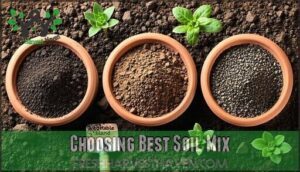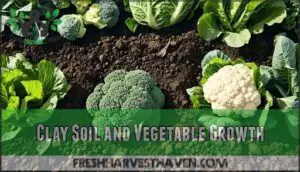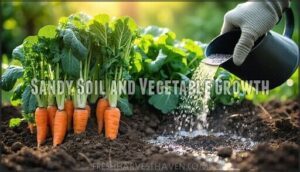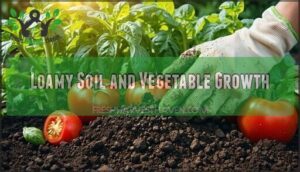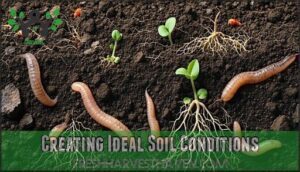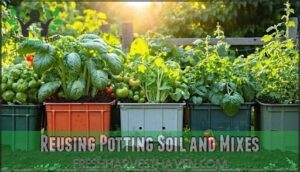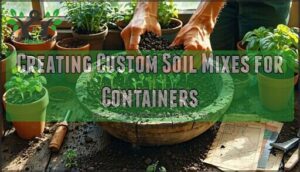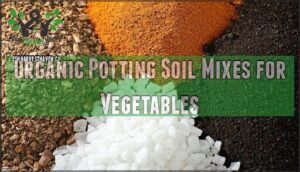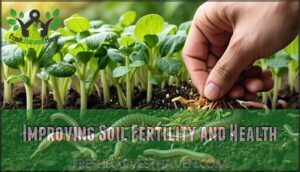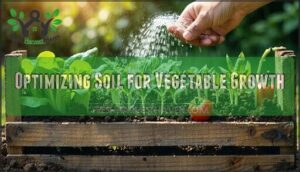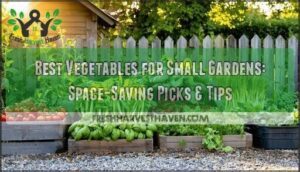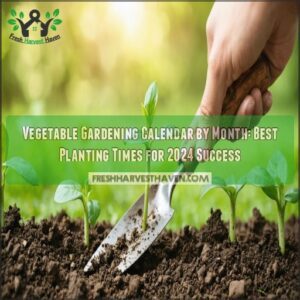This site is supported by our readers. We may earn a commission, at no cost to you, if you purchase through links.
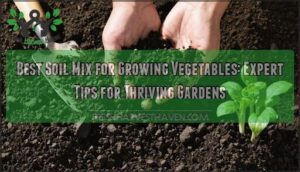
This blend guarantees nutrient-rich, aerated soil that retains moisture without waterlogging. Organic matter feeds your plants and fosters beneficial microbes.
Sand or perlite prevents roots from sitting in soggy soil, which vegetables hate. A good soil mix feels crumbly, holds its shape when squeezed, but falls apart with a light touch.
Test pH too—most veggies thrive in slightly acidic soil (6.0–7.0). Want a lush garden? Healthy soil is always step one, and it’s essential for a successful harvest.
Table Of Contents
- Key Takeaways
- Soil Composition Matters
- Choosing Best Soil Mix
- Soil Types and Vegetables
- Creating Ideal Soil Conditions
- Soil Mixes for Container Vegetables
- Preparing Soil for Vegetables
- Improving Soil Fertility and Health
- Optimizing Soil for Vegetable Growth
- Frequently Asked Questions (FAQs)
- What is the best soil combination for vegetables?
- What is the best soil mixture for a raised vegetable garden?
- What is the best potting mix for vegetables?
- What is the best soil for starting vegetables?
- What kind of soil is best for a raised vegetable garden?
- What is the best top soil for a vegetable garden?
- Can vegetables grow in rocky soil areas?
- How to prevent soil from waterlogging issues?
- What soil pH works best for vegetables?
- Can you use soil straight from the yard?
- Conclusion
Key Takeaways
- Mix 40% organic matter (like compost), 30% garden soil, and 30% sand or perlite for a nutrient-rich, well-draining base.
- Test your soil’s pH to keep it slightly acidic (6.0–7.0) since most vegetables thrive in this range.
- Add compost and organic matter regularly to boost nutrients, improve water retention, and support soil microbes.
- Use loamy soil or enhance clay and sandy soils with organic amendments for better drainage and fertility.
Soil Composition Matters
You can’t grow healthy vegetables without understanding what’s in your soil. The right balance of minerals, organic matter, water, and air creates the foundation plants need to thrive.
Minerals and Organic Matter
Minerals and organic matter are the backbone of healthy soil, boosting vegetable growth. These components enhance soil fertility and nutrient cycling while improving water retention.
Minerals and organic matter fuel soil fertility, strengthening vegetable growth with nutrient cycling and improved water retention.
Focus on these essentials for robust soil composition:
- Sand, silt, and clay provide key mineral composition.
- Organic decomposition enriches soil nutrients.
- Humus retains moisture and aids stabilizing soil pH.
- Balanced soil nutrients promote vegetable health.
Soils also require essential living organisms for nutrient cycling and to maintain a healthy soil composition.
Living Organisms and Water Content
Healthy soil thrives with living organisms like bacteria, fungi, and earthworms.
Bacteria, fungi, and earthworms are nature’s soil champions, transforming dirt into a thriving, nutrient-rich foundation for healthy plants.
These soil microbes break down organic matter, improving water retention and aeration needs.
By enhancing soil moisture and supporting root health, these organisms create balance.
Adding compost boosts organism benefits and sustains soil microorganisms, promoting drainage while ensuring nutrients are readily available for your vegetable garden’s success.
Ideal Soil Structure and Porosity
An ideal soil structure and porosity are key to thriving vegetables.
Loam soil, with balanced particles, promotes aeration and water drainage.
Aggregate stability prevents compaction while supporting water infiltration and root penetration.
Aim for maximum oxygen availability to enhance growth.
- Choose loam soil for vegetables.
- Verify proper soil drainage.
- Prevent compaction by avoiding over-tilling.
- Test soil porosity regularly.
- Add organic matter for improved texture.
Choosing Best Soil Mix
Picking the right soil mix is key to growing healthy vegetables, no matter your experience level.
By understanding the differences between garden soil, potting soil, and specialized organic mixes, you’ll set your plants up for success.
Garden Soil Vs Regular Soil
When comparing garden soil and regular soil, consider soil composition, nutrient content, and water retention.
Garden soil works best in a vegetable garden due to its enriched nutrients.
Regular soil suits landscaping but often needs improvement for vegetables.
The key differences between garden soil and regular soil are crucial for successful gardening and landscaping projects.
Garden Soil Vs Potting Soil
Garden soil’s nutrient density makes it perfect for outdoor beds, mixing well with native dirt.
But it’s too heavy for container gardening, risking poor water retention and root rot.
Potting mix vegetables thrive in lightweight, aerated blends designed for containers.
A soil mix recipe with proper garden soil composition or customized amendments can transform any vegetable garden soil into a productive haven.
Organic Soil Mixes for Vegetables
A great organic vegetable soil starts with the right soil mix recipe.
Consider these essentials for vibrant vegetable garden soil:
- DIY soil mix: Combine 1/3 compost, 1/3 peat moss, 1/3 vermiculite.
- Compost benefits: Boosts nutrients and soil structure.
- Worm castings: Add natural nutrients for vegetables.
- Check soil pH: Keep it between 6-7 for nutrient balance.
Soil Types and Vegetables
Matching your vegetables to the right soil type can make all the difference in their growth and health.
Understanding how clay, sandy, or loamy soils impact nutrient retention and water drainage helps you create the best environment for your plants.
Clay Soil and Vegetable Growth
Clay soil challenges include poor drainage and compaction, which can stress plants.
However, its abundant nutrients benefit certain brassicas. To improve soil structure, mix in compost or sand for better aeration. Focus on clay soil vegetables that thrive in moisture-rich environments.
| Clay Soil Advantages | Challenges | Vegetables Suited | Amendment Tips |
|---|---|---|---|
| Nutrient dense | Poor drainage | Broccoli, Cabbage | Add compost for aeration |
| Retains moisture | Heavy and sticky | Brussels Sprouts | Combine with sand for porosity |
| Fertile for feeding crops | Hard to work with | Kale, Mustard Greens | Loosen soil with organic matter |
| Drought resistant | Compaction limits roots | Cauliflower | Apply gypsum to soften clay |
Sandy Soil and Vegetable Growth
Sandy soil is light and drains quickly, making it ideal for sandy soil vegetables like carrots. However, its loose texture needs support for nutrient retention and root development.
Adding organic matter can substantially improve sandy soil.
To manage sandy soil effectively, consider the following strategies:
- Add sandy amendments like compost.
- Increase watering frequency to combat nutrient leaching.
- Mulch to reduce wind erosion.
- Choose soil drainage vegetables that thrive in drier textures.
- Test soil often for fertility.
Loamy Soil and Vegetable Growth
Loamy soil is a superhero for vegetable gardening, blending clay, sand, and silt into a nutrient-rich, well-draining mix.
It supports loam soil vegetables like root crops, thanks to its balanced structure and soil nutrients vegetables need.
Loam benefits include holding moisture without waterlogging, and enhancing it with organic amendments like compost guarantees thriving vegetables all season, with proper loam management.
Enhance it with organic amendments like compost, and proper loam management guarantees thriving vegetables all season, thanks to its well-draining mix.
Creating Ideal Soil Conditions
You’ll grow healthier vegetables by focusing on the right balance of organic matter, nutrients, and structure in your soil.
It’s all about creating conditions where roots can thrive, water drains well, and essential nutrients are easy for plants to access.
Adding Organic Matter and Compost
Adding organic matter like compost and mulch transforms your soil into a thriving plant haven.
Compost benefits include better water retention, aeration, and nutrient supply for vegetables, and can be paired with organic amendments like manure for extra fertility.
Cover crops improve structure while adding nutrients, and these soil amendments enrich your garden, ensuring healthy, robust plants without breaking the bank, thanks to the benefits of compost and organic matter.
Balancing Nutrients and Fertilizer
Balancing nutrients and fertilizer guarantees vegetable growth thrives.
Start with soil testing to identify nutrient deficiencies and determine the right nutrient ratios.
Use organic amendments like compost or manure to improve soil fertility.
Choose fertilizer types suited for vegetables, balancing nitrogen, phosphorus, and potassium.
To begin, consider using a convenient soil analysis.
Watch for deficiency symptoms like yellowing leaves to adjust soil nutrients effectively.
- Test soil for nutrient deficiencies
- Add compost for organic support
- Select balanced fertilizers for vegetables
- Monitor soil pH for ideal nutrient uptake
Maintaining Soil Health and Structure
Healthy soil thrives on balance. Prevent compaction with aeration techniques like regular tilling or using cover crops.
Water management and erosion control help maintain soil structure, while adding organic matter boosts soil health and biology.
Support the soil food web by nurturing microorganisms—this enhances soil nutrients. Protect your garden’s foundation by focusing on these practices to keep it thriving.
Soil Mixes for Container Vegetables
When growing vegetables in containers, choosing the right soil mix is key to healthy plants and great harvests.
You’ll need a mix that provides good drainage, retains moisture, and is rich in nutrients to keep your plants thriving.
Reusing Potting Soil and Mixes
Reusing potting soil saves money and helps the environment.
Start by sterilizing old soil to eliminate pests or diseases.
Follow these steps:
- Test for nutrient depletion and enhance with amendments like compost or organic matter.
- Rotate soil use to maintain fertility and prevent issues.
- Avoid overuse by repotting annually to sustain soil health and structure.
Ensuring containers have proper drainage holes is also essential for preventing root rot, which is crucial for maintaining good soil structure.
Creating Custom Soil Mixes for Containers
Crafting a custom vegetable container soil is simple. Combine loam, compost, and perlite for ideal drainage and nutrient balance.
Sterilization methods, like baking, prevent pests. Adjust pH for specific plants—most prefer slightly acidic blends.
Test soil combinations in small batches for container plants before scaling up. You can even purchase pre-made soil mixes for convenience.
Quality mixes guarantee better growth and healthier roots in vegetable container soil, making it a critical component for a successful harvest, and ensuring the use of high-quality materials.
Organic Potting Soil Mixes for Vegetables
For container vegetables, organic potting soil is a game-changer.
Use a DIY soil mix combining coco coir for water retention, compost for nutrient density, and perlite for drainage. Add peat moss for balancing moisture and organic matter.
- Coco coir improves soil structure and aeration.
- Compost ratios enrich nutrients naturally.
- Perlite benefits prevent waterlogging while boosting plant health.
Preparing Soil for Vegetables
Preparing soil for vegetables means setting the stage for strong roots, healthy plants, and better yields.
You’ll need to focus on proper methods like tilling, double digging, or no-dig techniques to create the right conditions for growth.
Tilling and Double Digging Methods
Tilling benefits soil preparation by breaking compacted layers, improving aeration, and making nutrients accessible.
Double digging goes deeper, loosening the soil while preserving structure, though it’s labor-intensive.
Both methods help manage soil cultivation but can disturb microorganisms.
Adding organic matter enriches the soil for better growth.
Consider alternative methods if excessive soil disturbance is a concern.
Proper soil tillage enhances drainage and fertility, supporting vegetable growth in managed gardens, which benefits from improving aeration and making nutrients accessible, and ultimately leads to better vegetable growth.
The No-Dig Method for Soil Preparation
The no-dig method simplifies soil preparation for vegetables while boosting soil health.
Here’s how:
- Mow vegetation and clear large debris.
- Lay overlapping cardboard sheets to suppress weeds.
- Water thoroughly and add a six-inch compost layer—perfect for vegetables.
- Let organic matter nurture soil organisms, improving fertility naturally.
No-dig benefits include healthier plants, fewer weeds, and reduced fertilizer use, which ultimately leads to reduced fertilizer use.
Improving Soil Fertility and Health
You can boost your soil’s fertility by adding organic fertilizers, compost, and nutrient-rich materials like worm castings.
Simple practices like mulching and planting cover crops also improve soil health, ensuring your vegetables thrive.
Using Organic Fertilizers and Compost
Great soil starts with feeding it right.
Organic fertilizers and compost enrich soil fertility by boosting nutrient cycling and supporting soil microbes.
Compost benefits include improved structure and moisture retention, making it perfect for vegetables.
Different fertilizer types suit unique needs—balanced, slow-release, or specific nutrients.
Sustainable gardening thrives on organic matter, so embrace compost for vegetables and fertilizer for vegetables confidently, using organic matter!
Adding Beneficial Microorganisms and Worm Castings
Boosting soil biology with worm castings enriches your garden’s nutrient profile and protects plants from diseases.
Packed with beneficial microbes and organic matter, they enhance soil structure and water retention. You can easily buy worm castings for your garden.
Try these tips:
- Add castings during planting for a nutrient boost.
- Use compost tea for microbe benefits.
- Combine castings with compost for improved soil biology.
- Practice vermicomposting for organic inoculation.
Mulching and Cover Cropping for Soil Health
Mulching and cover crops work wonders for soil health.
Mulch benefits include water retention, weed suppression, and soil erosion control.
Organic mulches, like straw, add organic matter as they break down.
Cover crops, such as clover and rye, improve soil structure, enrich nutrients, and prevent erosion.
These practices guarantee healthier vegetables by promoting soil improvement and long-term fertility.
Optimizing Soil for Vegetable Growth
You can’t grow thriving vegetables without giving your soil the care it needs.
By adjusting its pH, improving structure, and keeping it well-maintained, you’ll set the perfect stage for healthy, productive plants.
Adjusting Soil PH for Optimal Growth
Soil pH directly impacts nutrient availability for vegetables, so testing soil pH is smart before planting.
Most soil pH vegetables thrive between 6.5 and 7.0.
If your garden’s acidic, consider amending soil acidity with lime. For alkaline soil solutions, try elemental sulfur.
Regular soil testing guarantees your vegetables get the best growing conditions, keeping them healthy and productive.
Enhancing Soil Structure and Water Retention
Enhancing soil structure and water retention is essential for thriving vegetables.
Focus on organic matter, compost, and smart soil amendments.
Try these:
- Mix vermiculite for better soil aeration and water retention.
- Add organic matter to improve clay soil structure.
- Use mulch to retain moisture in sandy soil.
- Combine sandy soil solutions like compost for nutrients.
- Test soil regularly for balanced water absorption.
Monitoring and Maintaining Soil Health for Vegetable Growth
Regular soil testing is your best friend for thriving vegetables.
Check nutrient levels, pH balance, and moisture regularly to avoid surprises.
Manage soil health by adding amendments like compost or organic matter as needed.
Watch for pests disrupting roots, and make simple tweaks, like adjusting moisture or using targeted fertilizers, to guarantee healthy soil for strong vegetable growth all season.
Frequently Asked Questions (FAQs)
What is the best soil combination for vegetables?
For growing vegetables, mix one-third compost, one-third peat moss or coconut coir, and one-third vermiculite or perlite.
This blend balances nutrients, moisture retention, and drainage, giving your plants the perfect foundation to thrive, with complete concepts of plant care in mind.
What is the best soil mixture for a raised vegetable garden?
Did you know loamy soil can boost vegetable yield by up to 25%? Use a mix of 1/3 compost, 1/3 peat moss or coir, and 1/3 vermiculite for rich, well-draining raised beds.
What is the best potting mix for vegetables?
The ideal potting mix for vegetables combines compost, peat moss or coconut coir, and perlite or vermiculite for drainage.
This blend balances nutrients, moisture, and air, ensuring healthy roots and vigorous vegetable growth in containers.
What is the best soil for starting vegetables?
Perfect potting combines coco coir, compost, vermiculite, and peat moss, promising prime plant potential.
Stick with a mix that holds moisture, drains well, and brings balanced nutrients—it’s the secret to sprouting success.
What kind of soil is best for a raised vegetable garden?
For a raised vegetable garden, mix equal parts compost, peat moss (or coconut coir), and vermiculite.
This blend guarantees excellent drainage, moisture retention, and nutrient availability, giving your plants the balanced environment they crave.
What is the best top soil for a vegetable garden?
When crafting a veggie haven, rich loamy topsoil is your best friend.
Look for soil that’s dark, crumbly, and nutrient-packed, with good drainage and organic matter to nourish roots and fuel hearty growth.
Can vegetables grow in rocky soil areas?
Yes, vegetables can grow in rocky soil, but it’s tricky.
You’ll need to improve the soil by removing rocks, adding compost, and creating raised beds.
Root vegetables struggle most, but hardier plants like beans thrive.
How to prevent soil from waterlogging issues?
To prevent waterlogging, improve drainage by adding organic matter like compost or sand, elevate planting beds, and aerate compacted soil.
Consider installing drainage trenches or using raised beds to keep roots dry and healthy, and to further enhance soil conditions for optimal plant growth, maintaining healthy roots is crucial.
What soil pH works best for vegetables?
Think of soil pH like a recipe’s secret ingredient—vegetables grow best in slightly acidic soil with a pH of 6 to
It helps plants absorb nutrients, ensuring a lush, productive garden, with slightly acidic soil being key to this process.
Can you use soil straight from the yard?
Using soil from your yard is possible, but it’s often too compact, lacking nutrients and proper drainage.
Mix it with compost, sand, or perlite for better results.
Always test for pH and contaminants first.
Conclusion
Strangely enough, the "secret" to a thriving vegetable garden isn’t a secret at all—it’s the soil.
By creating the best soil mix for growing vegetables, you’re setting the foundation for lush, productive plants.
Combine organic matter, garden soil, and sand or perlite for a nutrient-rich, well-draining base.
Keep an eye on pH, adjust as needed, and don’t forget to nurture your soil’s health over time.
Healthy soil equals healthy vegetables, making every harvest worth the effort!


